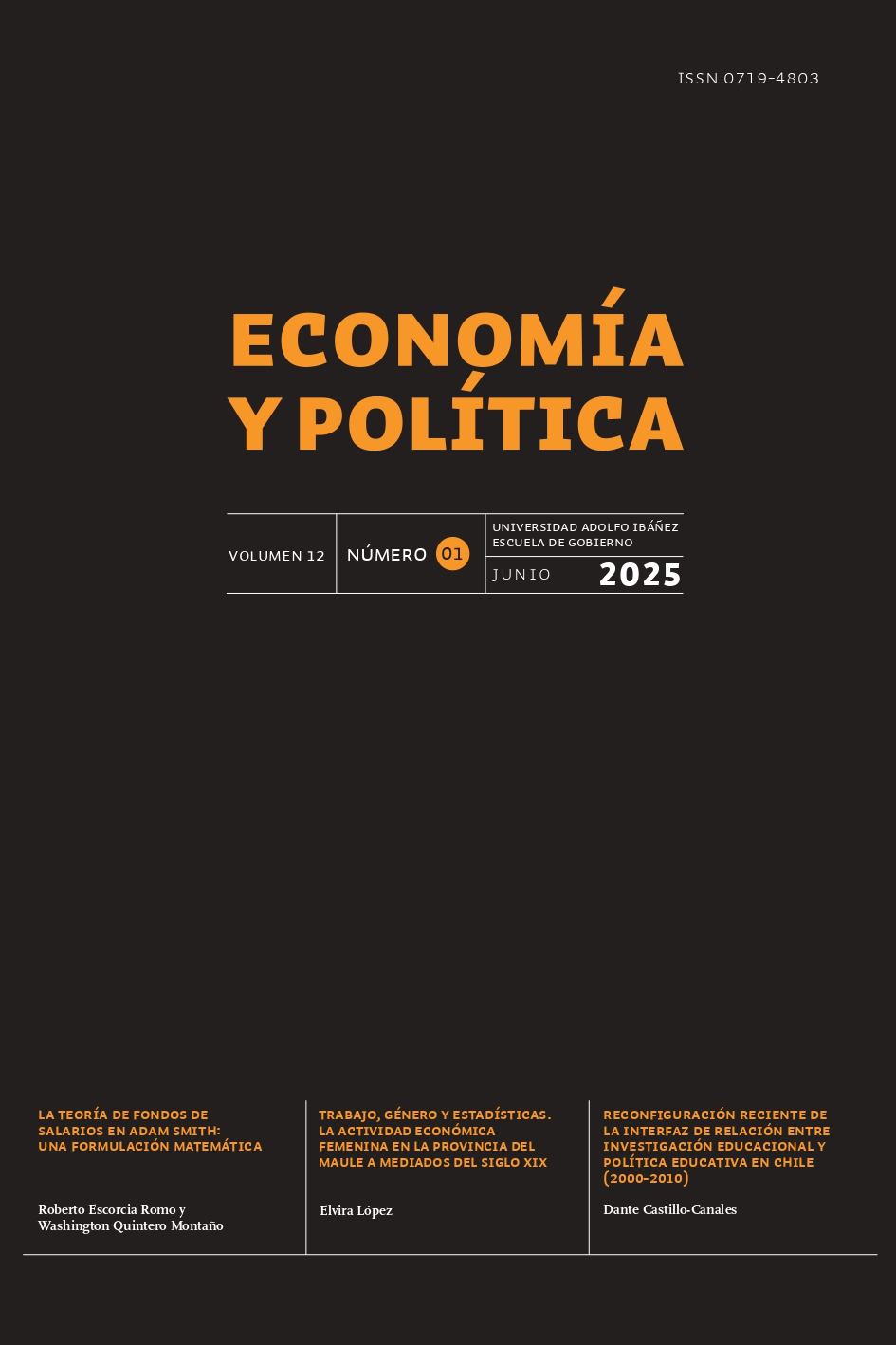The Adam Smith's Wage Fund Theory: A Mathematical Formulation
DOI:
https://doi.org/10.15691/07194714.2025.001Keywords:
Adam Smith, income distribution, economic growth, market wage, natural wage, labor marketAbstract
This paper puts forth a mathematical formalization of the wage fund theory presented by Adam Smith in his 1776 treatise, An inquiry into the Nature and Causes of the Wealth of Nations. The fundamental tenets of Smith's wage fund theory are elucidated herein. The concept of the natural wage, which represents the focal point around which the market wage oscillates, is thus reaffirmed. It is demonstrated that the most pivotal notion pertaining to Smithian wage dynamics is situated in the divergence between the market wage and the natural wage, and in the potential for unemployment within the model as a fundamental mechanism of adjustment between the two (gravitation).
References
Acuña, O. y Ulate, F. 2008. Adam Smith y sistemas dinámicos. Revista de Ciencias Económicas 26(1), 171-185. https://www.researchgate.net/publication/28294928_Adam_Smith_y_Sistemas_Dinamicos
Beenstock, M. 1988. Modelling the Labour Market. Nueva York: Chapman and Hall Bidard, C. y Klimovsky, E. 2014. Capital, salario y crisis: un enfoque clásico. México: Siglo XXI, 1ª ed.
Bilbao, A. 1993. Hobbes y Smith: Política, economía y orden social. Reis. Revista Española de Investigaciones Sociológicas (61), 127-144. DOI: https://doi.org/https://doi.org/10.2307/40183619
Cartelier, J. 1986. Excedente y reproducción: la formación de la economía política clásica. México: Fondo de Cultura Económica.
Chancel, L., Piketty, T., Saez, E. y Zucman, G. 2022. World Inequality Report 2022. World Inequality Lab. https://bit.ly/40hGBAA
Chandra, R. 2004. Adam Smith, Allyn Young, and the Division of Labor. Journal of Economic Issues 38(3), 787-805. http://www.jstor.org/stable/4228057
Díaz Calleja, E. 1997. Los salarios en la economía política clásica: algunas consideraciones sobre la doctrina clásica del mercado de trabajo. Revista Andaluza de Relaciones Laborales (3), 111-127. https://bit.ly/4aHCFMc
Eymard-Duvernay, F. 2008. Defectos de cooperación y desempleo: una teoría institucionalista (23-73). En J. Neffa, Teorías económicas sobre el mercado de trabajo: III. Análisis institucionalista. Fondo de Cultura Económica.
Goodwin, R. 1967. A Growth Cycle (165-170). En C. Feinstein, Socialism, Capitalism and Growth. Cambridge University Press.
Goodwin, R. y Punzo, L. 1988. The Dynamics of a Capitalist Economy: A Multisectoral Approach. Routledge.
Hurtado Prieto, J. 2003. La teoría del valor de Adam Smith: la cuestión de los precios naturales y sus interpretaciones. Cuadernos de Economía 22(38), 15-45. https://dialnet.unirioja.es/servlet/articulo?codigo=2514776
Keynes, J. 2014. Teoría general de la ocupación, el interés y el dinero. Fondo de Cultura Económica.
Lewis, T. 1977. The Labor Market as the Basis of Natural Right. Journal of Economic Issues 11(1), 21-50. DOI: https://doi.org/https://doi.org/10.1080/00213624.1977.11503411
Long, J. y Plosser, C. 1983. Real Business Cycles. Journal of Political Economy 91(1), 39-69. DOI: https://doi.org/https://doi.org/10.1086/261128
Marx, K. 1980. Teorías sobre la plusvalía. Vol. 1. Fondo de Cultura Económica.
Marx, K. [1872] 1987. Das Kapital: Kritik der Politischen Ökonomie. Hamburgo: Erster Band, Dietz Verlag.
McCallum, B. 1989. Real Business Cycle Models (16-50). En R. Barro, Modern Business Cycle Theory. Cambridge, MA: Harvard University Press.
McCauley, J. 2000. The Futility of Utility: How Market Dynamics Marginalize Adam Smith. Physica 285(3-4), 506-538. DOI: https://doi.org/10.1016/S0378-4371(00)00296-X
Medio, A. y Lines, M. 2001. Nonlinear Dynamics: A Primer. Cambridge University Press.
Pasinetti, L. 1960. A Mathematical Formulation of the Ricardian System. The Review of Economic Studies 27(2), 78-98. http://www.jstor.org/stable/2296129
Piketty, T. 1997. L'économie des inégalités. París: La découverte.
Piketty, T. 1998. Les hauts revenus face aux modifications des taux marginaux supérieurs de l’impôt sur le revenu en France, 1970-1996. CEPREMAP. https://bit.ly/3OamP2s
Piketty, T. 2013. Le capital au XXIe siècle. París: Le Seuil.
Ploeg, F. 1983. Implications of Workers’ Savings for Economic Growth and the Class Struggle (1-13). En R. Goodwin, M. Krueger y A. Vercelli, Lecture Notes in Economics and Mathematical Systems. Springer-Verlag.
Poinsot, F. 2018. El fondo de salarios como modelo mental: Una “ficción económica” o un “juguete bonito” de los albores de la ciencia económica (1-24). Reunión Anual AAEP 2017. https://bit.ly/3Oc8IJW
Rahim, E. 2011. The Concept of Abstract Labour in Adam Smith's System of Thought. Review of Political Economy 23(1), 95-110. DOI: https://doi.org/10.1080/09538259.2011.526296
Ricardo, D. 2014. Principios de economía política y tributación. Fondo de Cultura Económica.
Rumbos, I. y Lomelí, H. 2007. Métodos dinámicos en economía: otra búsqueda del tiempo perdido. Cengage Learning Latinoamérica.
Smith, A. 2000. Una investigación sobre la naturaleza y las causas de la riqueza de las naciones. Fondo de Cultura Económica, 19a ed.
Smith, A. 2012. The Wealth of Nations - An inquiry into the Nature and Causes of the Wealth of Nations, ed. Edwin Cannan. University of Chicago Press, 18a ed.
Smith, N. 2012. Development as Division of Labor: Adam Smith Meets Agent-Based Simulation. SSRN Electronic Journal, 1-48. DOI: https://doi.org/10.2139/ssrn.2173846
Stirati, A. 1994. The Theory of Wages in Classics Economics. A Study of Adam Smith, David Ricardo and their Contemporaries. Edward Elgar Publishing Limited.
Waterman, A. 2009. Adam Smith’s Macrodynamic Conception of the Natural Wage. History of Economics Review 49(1), 45-60. DOI: https://doi.org/10.1080/18386318.2009.11682141


